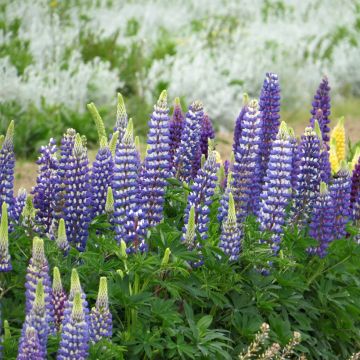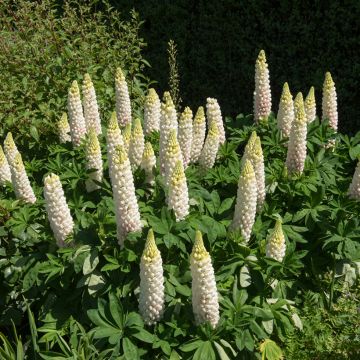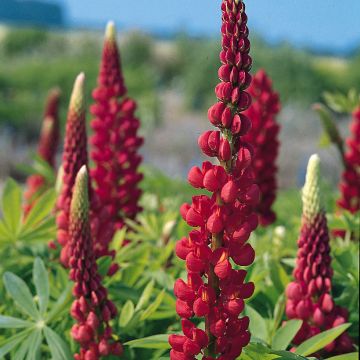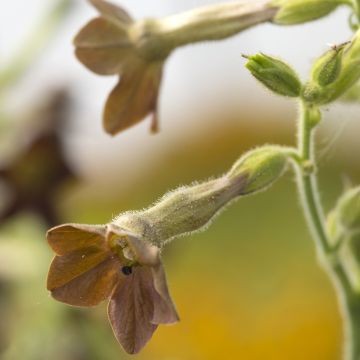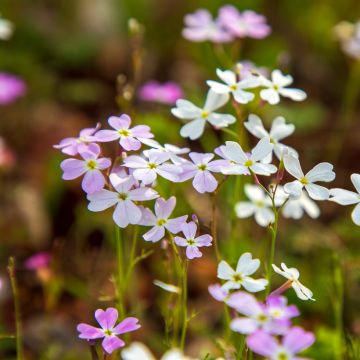

Lupin Tutti Frutti
Lupinus Tutti Frutti - Large-leaved Lupine seeds
Lupinus polyphyllus Tutti Frutti
Large-leaved Lupine, Big-leaved Lupine, Garden Lupin, Russell Lupin
Fantastic! Ordered a year ago, I received beautiful and abundant flowers.
Florence, 11/08/2017
Special offer!
Receive a €20 voucher for any order over €90 (excluding delivery costs, credit notes, and plastic-free options)!
1- Add your favorite plants to your cart.
2- Once you have reached €90, confirm your order (you can even choose the delivery date!).
3- As soon as your order is shipped, you will receive an email containing your voucher code, valid for 3 months (90 days).
Your voucher is unique and can only be used once, for any order with a minimum value of €20, excluding delivery costs.
Can be combined with other current offers, non-divisible and non-refundable.
Why not try an alternative variety in stock?
View all →This plant carries a 6 months recovery warranty
More information
We guarantee the quality of our plants for a full growing cycle, and will replace at our expense any plant that fails to recover under normal climatic and planting conditions.

Would this plant suit my garden?
Set up your Plantfit profile →
Description
Lupinus 'Tutti Frutti' is a selection with breathtaking colours: mauve, pink, red, yellow and white, all bicoloured. These perennial lupins produce compact clusters of flowers which are larger than most varieties, providing a unique spectacle with their colourful flowers in unprecedented shades.
The lupin is a genus that includes 200 to 1000 species, native to the American continent. They can be annual or perennial, herbaceous or woody. Prolific lupins are used for food, fodder or ornamental purposes, depending on the variety. However, be aware that the seeds of most ornamental species contain high levels of alkaloids and are very toxic. Lupins used for food are called 'sweet lupins'.
The 'Tutti Frutti' Lupin has an exceptionally opulent flowering from May to August. The colours of the bicoloured flowers are mostly unprecedented and create a striking contrast with the glaucous green foliage. This variety reaches a metre in height and pairs perfectly with delicate grasses to lighten up romantic compositions.
Its height and architecture will create relief and structure in the garden and despite its large size, it is robust and does not need to be staked. Lupins like moist, deep and acidic soils, and can be grown in full sun or light partial shade. Remember to cut the flower spikes for impressive cut flowers and to prevent the seeds from self-sowing.
Legumes' beneficial effects on the soil have been recognised since ancient times. The Greeks and Romans knew that they can regenerate depleted soils by fixing nitrogen from the air in their roots. A symbiosis with bacteria allows for an exchange of nutrients that benefits all parties. This knowledge led to the use of crop rotation. Some species are used for their qualities as green manure, while others are used for their emulsifying power, which can replace eggs in culinary preparations (people with allergies may be able to use lupin flour).
Report an error about the product description
Flowering
Foliage
Plant habit
Safety measures
Botanical data
Lupinus
polyphyllus
Tutti Frutti
Fabaceae
Large-leaved Lupine, Big-leaved Lupine, Garden Lupin, Russell Lupin
Cultivar or hybrid
ingestion
Cette plante est toxique si elle est ingérée volontairement ou involontairement.
Ne la plantez pas là où de jeunes enfants peuvent évoluer, et lavez-vous les mains après l'avoir manipulée.
Pensez à conserver l'étiquette de la plante, à la photographier ou à noter son nom, afin de faciliter le travail des professionnels de santé.
Davantage d'informations sur https://plantes-risque.info
Other Lupin seeds
View all →Planting and care
Soak your seeds overnight in cold water before sowing from late February to April under 0.3 cm (0in) of good seed compost at a temperature between 15 and 21 °C (59 and 69.8°F) at least. Germination usually takes 18 to 21 days. The substrate should remain moist without being wet. Once your seedlings are strong enough to handle, transplant them into well-prepared soil, making sure to space them at least 30 cm (12in) apart. You can also sow directly in place in late spring when the soil is well warmed up, in well-prepared soil with a spacing of 30 cm (12in).
Sowing period
Intended location
-
, onOrder confirmed
Reply from on Promesse de fleurs
Similar products
Haven't found what you were looking for?
Hardiness is the lowest winter temperature a plant can endure without suffering serious damage or even dying. However, hardiness is affected by location (a sheltered area, such as a patio), protection (winter cover) and soil type (hardiness is improved by well-drained soil).

Photo Sharing Terms & Conditions
In order to encourage gardeners to interact and share their experiences, Promesse de fleurs offers various media enabling content to be uploaded onto its Site - in particular via the ‘Photo sharing’ module.
The User agrees to refrain from:
- Posting any content that is illegal, prejudicial, insulting, racist, inciteful to hatred, revisionist, contrary to public decency, that infringes on privacy or on the privacy rights of third parties, in particular the publicity rights of persons and goods, intellectual property rights, or the right to privacy.
- Submitting content on behalf of a third party;
- Impersonate the identity of a third party and/or publish any personal information about a third party;
In general, the User undertakes to refrain from any unethical behaviour.
All Content (in particular text, comments, files, images, photos, videos, creative works, etc.), which may be subject to property or intellectual property rights, image or other private rights, shall remain the property of the User, subject to the limited rights granted by the terms of the licence granted by Promesse de fleurs as stated below. Users are at liberty to publish or not to publish such Content on the Site, notably via the ‘Photo Sharing’ facility, and accept that this Content shall be made public and freely accessible, notably on the Internet.
Users further acknowledge, undertake to have ,and guarantee that they hold all necessary rights and permissions to publish such material on the Site, in particular with regard to the legislation in force pertaining to any privacy, property, intellectual property, image, or contractual rights, or rights of any other nature. By publishing such Content on the Site, Users acknowledge accepting full liability as publishers of the Content within the meaning of the law, and grant Promesse de fleurs, free of charge, an inclusive, worldwide licence for the said Content for the entire duration of its publication, including all reproduction, representation, up/downloading, displaying, performing, transmission, and storage rights.
Users also grant permission for their name to be linked to the Content and accept that this link may not always be made available.
By engaging in posting material, Users consent to their Content becoming automatically accessible on the Internet, in particular on other sites and/or blogs and/or web pages of the Promesse de fleurs site, including in particular social pages and the Promesse de fleurs catalogue.
Users may secure the removal of entrusted content free of charge by issuing a simple request via our contact form.
The flowering period indicated on our website applies to countries and regions located in USDA zone 8 (France, the United Kingdom, Ireland, the Netherlands, etc.)
It will vary according to where you live:
- In zones 9 to 10 (Italy, Spain, Greece, etc.), flowering will occur about 2 to 4 weeks earlier.
- In zones 6 to 7 (Germany, Poland, Slovenia, and lower mountainous regions), flowering will be delayed by 2 to 3 weeks.
- In zone 5 (Central Europe, Scandinavia), blooming will be delayed by 3 to 5 weeks.
In temperate climates, pruning of spring-flowering shrubs (forsythia, spireas, etc.) should be done just after flowering.
Pruning of summer-flowering shrubs (Indian Lilac, Perovskia, etc.) can be done in winter or spring.
In cold regions as well as with frost-sensitive plants, avoid pruning too early when severe frosts may still occur.
The planting period indicated on our website applies to countries and regions located in USDA zone 8 (France, United Kingdom, Ireland, Netherlands).
It will vary according to where you live:
- In Mediterranean zones (Marseille, Madrid, Milan, etc.), autumn and winter are the best planting periods.
- In continental zones (Strasbourg, Munich, Vienna, etc.), delay planting by 2 to 3 weeks in spring and bring it forward by 2 to 4 weeks in autumn.
- In mountainous regions (the Alps, Pyrenees, Carpathians, etc.), it is best to plant in late spring (May-June) or late summer (August-September).
The harvesting period indicated on our website applies to countries and regions in USDA zone 8 (France, England, Ireland, the Netherlands).
In colder areas (Scandinavia, Poland, Austria...) fruit and vegetable harvests are likely to be delayed by 3-4 weeks.
In warmer areas (Italy, Spain, Greece, etc.), harvesting will probably take place earlier, depending on weather conditions.
The sowing periods indicated on our website apply to countries and regions within USDA Zone 8 (France, UK, Ireland, Netherlands).
In colder areas (Scandinavia, Poland, Austria...), delay any outdoor sowing by 3-4 weeks, or sow under glass.
In warmer climes (Italy, Spain, Greece, etc.), bring outdoor sowing forward by a few weeks.






























